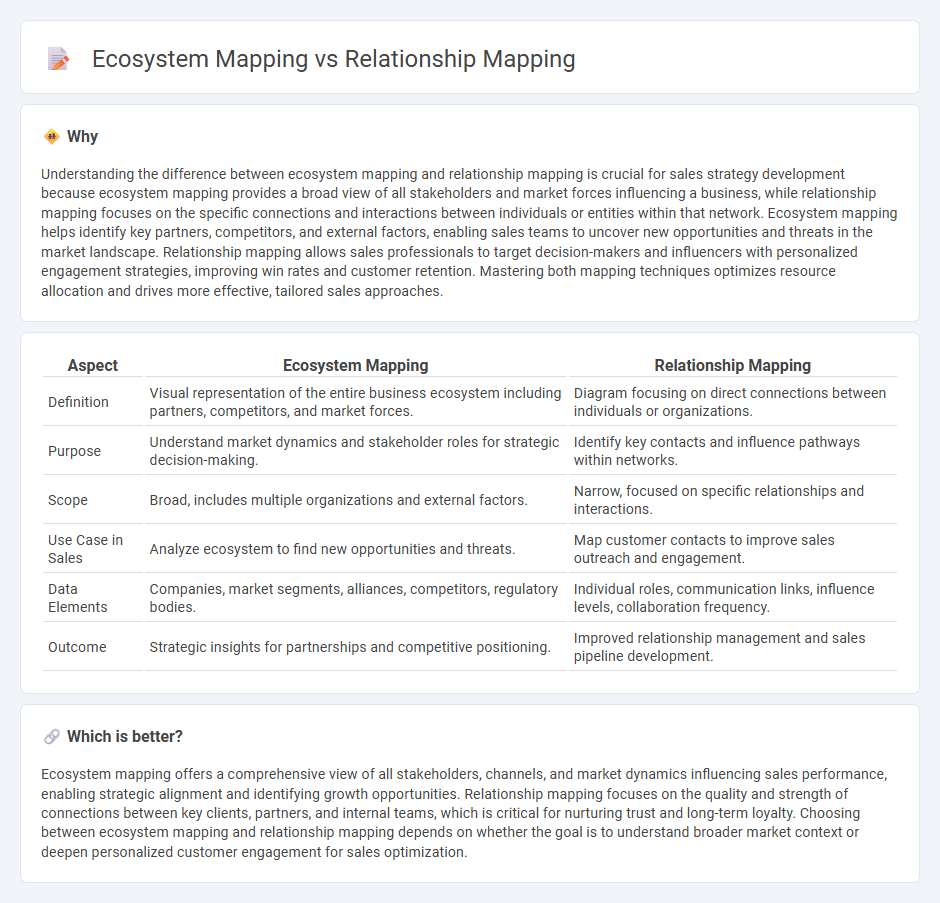
Sales ecosystem mapping identifies all external and internal entities influencing the customer journey, providing a comprehensive overview of market dynamics and key stakeholders. Relationship mapping focuses on the direct and indirect connections between individuals and organizations, revealing critical touchpoints and communication pathways that drive sales success. Explore the strategic advantages of integrating both methods to optimize your sales performance.
Why it is important
Understanding the difference between ecosystem mapping and relationship mapping is crucial for sales strategy development because ecosystem mapping provides a broad view of all stakeholders and market forces influencing a business, while relationship mapping focuses on the specific connections and interactions between individuals or entities within that network. Ecosystem mapping helps identify key partners, competitors, and external factors, enabling sales teams to uncover new opportunities and threats in the market landscape. Relationship mapping allows sales professionals to target decision-makers and influencers with personalized engagement strategies, improving win rates and customer retention. Mastering both mapping techniques optimizes resource allocation and drives more effective, tailored sales approaches.
Comparison Table
| Aspect | Ecosystem Mapping | Relationship Mapping |
|---|---|---|
| Definition | Visual representation of the entire business ecosystem including partners, competitors, and market forces. | Diagram focusing on direct connections between individuals or organizations. |
| Purpose | Understand market dynamics and stakeholder roles for strategic decision-making. | Identify key contacts and influence pathways within networks. |
| Scope | Broad, includes multiple organizations and external factors. | Narrow, focused on specific relationships and interactions. |
| Use Case in Sales | Analyze ecosystem to find new opportunities and threats. | Map customer contacts to improve sales outreach and engagement. |
| Data Elements | Companies, market segments, alliances, competitors, regulatory bodies. | Individual roles, communication links, influence levels, collaboration frequency. |
| Outcome | Strategic insights for partnerships and competitive positioning. | Improved relationship management and sales pipeline development. |
Which is better?
Ecosystem mapping offers a comprehensive view of all stakeholders, channels, and market dynamics influencing sales performance, enabling strategic alignment and identifying growth opportunities. Relationship mapping focuses on the quality and strength of connections between key clients, partners, and internal teams, which is critical for nurturing trust and long-term loyalty. Choosing between ecosystem mapping and relationship mapping depends on whether the goal is to understand broader market context or deepen personalized customer engagement for sales optimization.
Connection
Ecosystem mapping identifies key players, interactions, and value exchanges within a sales environment, while relationship mapping visualizes the specific connections and influences among stakeholders. Together, they provide a holistic view of market dynamics and customer networks, enabling sales teams to tailor strategies and improve engagement. This integrated approach enhances lead generation, opportunity identification, and sales pipeline management by uncovering hidden relationships and synergies.
Key Terms
**Relationship Mapping:**
Relationship mapping visually represents the direct connections and interactions between individuals, groups, or organizations, emphasizing communication flow and influence patterns. It highlights the nature and strength of relationships, helping identify key stakeholders and collaboration opportunities within a defined network. Explore further to understand how relationship mapping drives strategic decision-making and fosters effective partnerships.
Decision Makers
Relationship mapping highlights direct interpersonal connections among decision makers, revealing influence patterns and communication channels within an organization. Ecosystem mapping extends beyond individual ties to capture the broader network of stakeholders, including partners, competitors, and market forces impacting decision makers' strategies. Explore how integrating both approaches can enhance your understanding of decision-making dynamics.
Influencers
Relationship mapping identifies and visualizes direct connections and interactions between influencers within a network, emphasizing their roles and influence on one another. Ecosystem mapping provides a broader perspective by illustrating the entire environment influencers operate in, including stakeholders, platforms, and surrounding factors that impact their reach and effectiveness. Discover how leveraging these mapping techniques can optimize influencer strategies and amplify engagement outcomes.
Source and External Links
Relationship Mapping: Identify Key Teams, People, and Resources - A relationship map is a diagram that visually identifies essential teams, people, and resources within an organization to understand key relationships and influence for career or project success, starting from yourself at the center and including managers and close collaborators.
Relationship Mapping 101: What It Is and Why It Matters - Relationship mapping visually represents connections between people, organizations, or resources within a network to help identify key players, analyze information flow, and optimize collaboration through nodes, edges, and relationship data.
What is relationship mapping and how does it work? - Introhive - Relationship mapping creates a visualization of interconnected contacts within an organization, detailing relationship strength and contact history to help navigate complex deals with multiple stakeholders and optimize relationship-driven strategies for growth and success.
 dowidth.com
dowidth.com